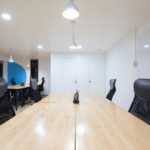The office space can be a place of focus and calm. We all get stressed at work sometimes. Whether it’s working on a new project or a tight deadline, stress can hold workers back from reaching their full potential! Here are our tips for a stress free office..
1. Quiet work-spaces
A quiet work-space can be the number one tool to help your employees optimise their concentration levels. In a post on ‘Hackernoon’, William Beck who works as a software strategist, conducted a survey and found that 58% of high-performing employees preferred their work-spaces to be silent and private for problem solving. He also found that 62% of employees, from his anonymous survey, said that their office space was too distracting. His work is contributing to an on-going series to help find the most optimal environments for high-performing employees (HBEs).
So far his findings go against the open-plan office spaces that are so common today.
2. Maximise natural lighting
A study by the Northwestern Medicine and the University of Illinois at Urbana – Champaign found that office workers who had more exposure to natural, white light had increased productivity. Mainly due to better sleep cycles.
Natural light, as opposed to artificial light can maintain these health benefits. Being exposed to natural light throughout the day can help an employee’s natural body clock, ensuring that when they put their head down at the end of the day, in darkness, their body is aware of the change in light and can produce those all important hormones that induce sleep.
“Light is the most important synchronising agent for the brain and body” – Ivy Cheung, co-author and Ph.D. candidate in Neuroscience.
Keeping workers desk spaces near to natural light sources, at least 20 – 25 feet away can make all the difference.
The study was reported in the Journal of Clinical Sleep Medicine in June 2014.
3. Designated relaxation areas
This one is much more simple than our previous tip. It’s requires a lot less work and you may not need to get your architect involved.
Designating areas within your office where employees can relax in quiet and comfortable spaces is certainly not a revolutionary idea, however it may be something that gets overlooked from time to time.
Assigning part of your office floor to become a ‘chill zone’ or break out area can make all the difference to your employees outlook and productivity.
Mark Zuckerberg’s Facebook has become well known for making use of this technique. Here is a video on YouTube, credit to Times Now. Zuckerberg explains his office set-up and covers some of the important design features of his work-spaces.
https://www.youtube.com/watch?v=rZR_lWoTQX8
Some companies have even gone as far as to make designated meditation rooms, full of plants and zen inducing ornaments.
If you would like to do the same, here is great place to start.
4. Establish collaboration spaces
Along with great places for workers to relax, it’s important to encourage great work-spaces for when employees are actually doing there jobs! Working together is essential and group exercises may already be encouraged in your office but, how about those all important meetings or collaborative group projects. Cramming round desks or piling into private offices is never ideal.
Impromptu meetings may be a regular occurrence in your office so having an inspiring work-space for employees to get together and combine their creative assets can only be seen as a plus. Having a collaborative space in your office makes sense when it comes to creativity so why not make that space as interesting and inspiring as possible.
In the past, scheduled meetings have many employees, and are set-up in formal work-spaces called meeting rooms, but with the recent changes in communication technology and conference calling it’s become more necessary for offices to provide creative spaces for those unexpected collaborations.
5. The cost of stress and employee voice.
Research from EnMast, which is an online community for business owners, found that almost $300 billion dollars was lost in revenues due to employee absenteeism, and loss of productivity. Almost 40% of workers, in their study, said that they were less productive because of stress related issues, such as loss of sleep and lack of appetite.
With a recession on-going, or round the corner, the majority of us worry about our job security and the longevity of our work. This overshadowing issue combined with increased work-load can prove to much for many of us.
By giving employees a voice, holding weekly meetings with HR and providing counselling sessions within the working week, you can create an environment where employees can feel comfortable with there work load as long as open communication is maintained throughout the business. Allowing employees to share ideas for improvement can be a positive step to stopping things spiralling out of control.




